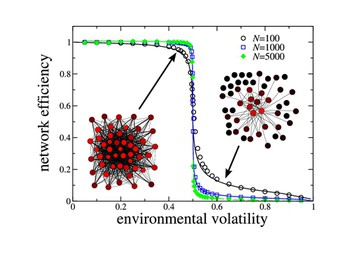Evolving Networks of Agents Competing For Centrality
This project is related to our research line: R&D networks. Duration: 36 months (October 2009 - September 2012) Funding program: Swiss State Secretariat for Education, Research and Innovation (SERI) (Project C09.0055)
This project is related to the EU COST Action MP0801 "Physics of Competition, Cooperation and Conflicts". It takes the 'bigger challenge' by aiming at social systems at large, to accomplish a new quantitative understanding of competition and conflicts. Because of the inherent complexity of socio-economic interaction, the outcome of such a global dynamics is (i) hard to predict, and (ii) difficult to control or to design. New theoretical approaches are thus needed to achieve this goal. In our project, we develop a general theoretical model of agents competing in social and economic networks. In particular, we identify potential sources of conflict that arise when agents do not internalize in their decisions the effects they cause on other agents. We test the networks generated by the model against the general empirical patterns found in real-world networks, such as R&D networks. Moreover, we evaluate the efficiency of certain network structures, to derive incentive mechanisms to optimize the interaction outcome. This shall mitigate the potential conflicts in presence of nonaligned utility functions. The figure below shows computer simulations that assume that agents prefer to connect to the neighbors of their neighbors that have a higher centrality, which creates local shortcuts. Network efficiency is measured on the basis of the aggregate centrality of agents. Environmental volatility measures the risk that if any single agent is exposed to an exogenous shock, it will force the deletion of one link. If the loss of links pushes the network efficiency down and environmental volatility up past some critical level, the strongly homogeneous network structure will break down into a sparse, hierarchical structure, similar to a core-periphery structure and is accompanied with a breakdown in network efficiency. 
Selected Publications
|
||||||||||||||||||||||||||||||